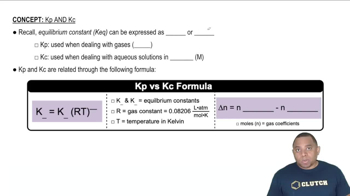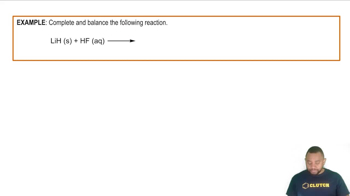Here are the essential concepts you must grasp in order to answer the question correctly.
Equilibrium Constant (Kc and Kp)
The equilibrium constant (K) quantifies the ratio of the concentrations of products to reactants at equilibrium for a given reaction. Kc is used for reactions in terms of molarity (concentration), while Kp is used for reactions involving gases and is expressed in terms of partial pressures. The relationship between Kc and Kp can be established using the ideal gas law, particularly when the number of moles of gas changes during the reaction.
Recommended video:
Phase of Reactants and Products
In equilibrium expressions, only the concentrations or partial pressures of gaseous and aqueous species are included; solids and liquids do not appear in the expression. This is because their activities are defined as 1, meaning they do not affect the equilibrium position. Understanding the phases of the reactants and products is crucial for correctly writing the equilibrium constant expressions.
Recommended video:
Production of Hydrogen Example
Stoichiometry in Equilibrium Expressions
The coefficients of the balanced chemical equation play a vital role in forming the equilibrium constant expression. For each species in the reaction, its concentration or pressure is raised to the power of its coefficient in the balanced equation. This stoichiometric relationship is essential for accurately calculating Kc and Kp, as it reflects the proportionality of the reactants and products at equilibrium.
Recommended video:
Equilibrium Constant Expressions
 Verified step by step guidance
Verified step by step guidance

